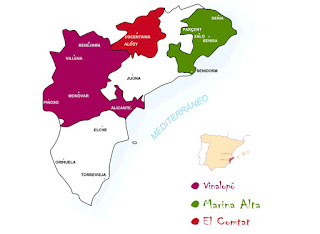- Developments in viticulture and oenology
- Climate change
- A resurgence of the perennial value of indigenous varieties
- A market eager to reward niche identities.
Alicante was awarded DO status in 1957. It is divided into two major zones and the area between:
- La Marina -- the northernmost region, sited in the coastal area between the towns of Denia and Calpe. The climate here is Mediterranean with annual rainfall of 500 mm. The soil is limestone and the vines are dedicated to the Moscatel grape.
- Vinalpo -- the southernmost region. Large, more inland section between the towns of Villena and Pinoso. The climate is continental and dry with rainfall of 300 mm/year. Primarily produces red wines from Monastrell. Iconic red is sweet Fondillon made from overripe grapes in the Rancio style.
- El Comtat -- the area between the two, both in terms of geography and climate. Produces both dry red and sweet white wines.
 |
| DO Alicante (Source: goodfoodrevolution.com) |
The soil in the region is limestone, with low levels of organic matter, and alluvial material, with some clay, near the coast.
When the DO was established in 1957, the requirements only allowed for Alicante Bouschet, Monastrell, Moscatel, and Bobal. The Moscatel (La Marina district) made delicious fortified and dessert wines, including the famed Moscatel de Alicante.
Why Alicante as an Emergent Region?
Alicante was once known as a region of bulk production and indifferent quality. However, according to Cellar Tours, a new generation of winemakers has come to understand which varieties fit their territories and, as a result, are producing some excellent blends that are more familiar to the world markets. In addition, these producers are also focusing on elegant and fresh reds,
According to BBR, the renovation of the infrastructure and vineyards in the region have helped rehabilitate Monastrell's reputation as it now produces "fleshy, concentrated, complex wines with intense violet and redcurrant notes."
******************************************************************************************************
The regions identified as emergent by Torres in his initial article are:
©Wine -- Mise en abyme
No comments:
Post a Comment